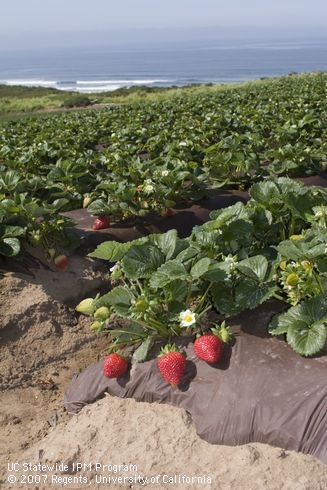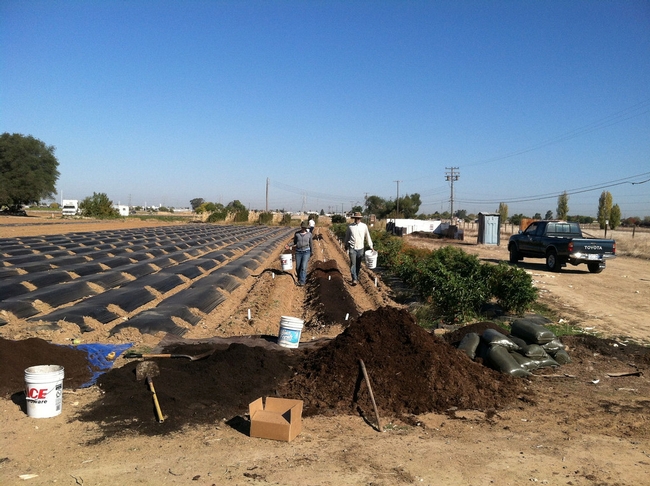Posts Tagged: methyl bromide
Can compost be an alternative to methyl bromide?
Writing on Earth Day, I am reminded of one of the world's major successes in environmental protection, the Montreal Protocol. Originally signed in 1987, it works to phase out ozone-depleting substanc
es, including the soil fumigant methyl bromide, commonly used by strawberry growers.Twenty-seven years later, the realities of enacting the Montreal Protocol are still taking shape, and strawberry growers are, with each harvest year, a step closer to a complete phase out of the fumigant and increased restrictions on alternative chemical fumigants used for disease suppression.
UC research has focused on how to make an economically viable and effective transition away from the soil fumigant. Initial alternatives include replacement chemical fumigants as well as biological fumigants such as anaerobic soil disinfection (such as putting tarps over fields to decrease oxygen), mustard seed meal amendment, or steam disinfestation.
But what if a practice many growers already use could also serve to suppress soil-borne diseases? What if growers could use a substance that provides multiple on-farm benefits?
Many conventional and organic growers alike use compost to boost soil fertility and organic matter. But compost's potential to serve other purposes, including suppressing disease, remain largely unexplored.
Ph.D. student Margaret Lloyd and Tom Gordon, professor in the Department of Plant Pathology at UC Davis, are hoping to close the gap in that knowledge. With a grant from the National Strawberry Sustainability Initiative, a program administered by University of Arkansas and funded by Walmart Foundation, and funding from UC Sustainable Agriculture Research and Education Program, Lloyd's research seeks to understand whether compost can contribute to disease suppression on a commercial scale, and how growers can best incorporate compost into their farm management to see its benefits.
“Compost is part of the production system that has potential as biological control,” says Lloyd. “Historically, we've only focused on it as a source of organic matter or soil nutrients. I'm trying to characterize its role in root health and soil health.”
The study evaluates the root health of strawberry plants, and compares plant yield and disease suppression across a number of research sites and compost types.
“In general, we talk about compost just as compost,” Lloyd said. “But it has drastically different qualities — soil fertility characteristics, physical properties, and microbial profiles. By focusing on different compost sources, the study will help growers better assess their available compost options to m
eet their farm needs.” Composts used in the study include worm compost, manure-based compost, spent mushroom compost, and municipal yard trimmings compost.Alternatives to methyl bromide have been a long time coming. “The research suggests that it won't be one technology replacing another, but a package of tools to help growers manage disease suppression in the soil,” Lloyd said. If some of those tools are already in a grower's tool kit, the transition away from fumigants will be that much smoother.
The research suggests a powerful Earth Day message for me: use what you have, but seek a deeper understanding of just how to use it.
Lloyd's research findings will be completed in 2014, with results available for growers in 2015. Visit the project's website for more information.
Methyl iodide debate continues despite registration
In the 10 months methyl iodide has been registered in California, no one in Monterey County has used it or even applied to use it, but the debate over whether anyone should is fresher than ever, the Salinas Californian reported last week.
The soil fumigant methyl bromide, which growers have depended on for decades, will no longer be available starting in 2015. Methyl iodide, a potential substitute, is a harmful chemical, but can be used safely with proper precautions, said UC Cooperative Extension weed scientist Steve Fennimore.
"The professional fumigators are really good," Fennimore said. "If the public saw how the companies do the fumigation, they'd probably be more comfortable with them."
Another fumigant, chloropicrin, is widely used in combination with methyl bromide and methyl iodide to provide the most pest-free soil for growers.
"Chloropicrin is really strong against fungi, and methyl bromide is really strong against weeds," Fennimore said. "When you use them together, there's a synergy. They're very complementary."
UC specialist looks into steam cleaning soil
UC researchers are considering the use of hot steam fumigation on coastal central California farms to prepare soil for planting strawberries and new orchards and vineyards. Farmers there have for years relied on methyl bromide, but the phase-out of the powerful soil fumigant is closing in, according to an article in The Packer.
To study the steam method, UC weed specialist Steve Fennimore outfitted a tractor with a boiler that heats steam to more than 300 degrees F. Ten-inch spikes inject steam into the ground.
The article, written by Elizabeth Ashby, said sandy or light soils are the easiest to treat, but Fennimore has had success in clay loam in Watsonville, Calif.
“This machine…there is something special about it,” Fennimore was quoted in the story. “It is surprising how fast it heats the soil. Within two minutes, it will take 60-degree soil and heat it to 200 degrees. It is like a microwave.”
The quick-acting treatment allows growers to steam in the morning and plant that afternoon when the ground has cooled. That stands in contrast to soil solarization, another possible methyl bromide alternative. Under the solarization system, the field is covered with plastic and the sun heats the soil and kills pathogens. Solarization takes six weeks.
One drawback of the steam system, however, is cost. Fennimore calculated that operating the steam machine, labor and fuel run $4,200 per acre. Methyl bromide in California costs $2,700 to $3,000 per acre. Applying steam to raised beds rather than entire fields could cut expenses to about $3,000 per acre.
Future studies will examine less expensive fuels like propane, ways to speed up the steam injection process and spot treatments.

UC specialist Steve Fennimore is studying steam soil treatment.
Scientific panel suggests state ban methyl iodide
The Fresno Bee ran a story on the front page this morning reporting that a scientific panel recommended that the California State Department of Pesticide Regulation reject a request by Tokyo-based Arysta LifeScience Corp. to approve the use of methyl iodide for pest control on California farms and in structures.
The eight-member Scientific Review Committee, chaired by UCLA environmental health sciencies professor John Froines, includes UC San Francisco medicine professor Paul Blanc, UC Berkeley public health professor Katharine Hammond and UC Berkeley environmental health sciences professor Tom McKone.
Methyl iodide was approved by the U.S. Environmental Protection Agency and many other states, but if California rejects the use of the pesticide, the U.S. EPA "may choose to initiate reevaluation of the methyl iodide registration," according to the panel's report to DPR.
"Based on the data available, we know that methyl iodide is a highly toxic chemical and we expect that any anticipated scenario for the agricultural or structural fumigation use of this agent would result in exposures to a large number of the public and thus would have a significant adverse impact on the public health," the panel wrote.
Farmers, however, believe methyl iodide would be an important tool in their arsenal for controlling soil pests in nursery containers and in the field before planting strawberries or establishing new orchards. The chemical could replace methyl bromide, which has been phased out because it damages the Earth's ozone layer.
"The products that we have just don't do the job," Bee reporter Robert Rodriguez quoted Barry Bedwell, president of the California Grape and Tree Fruit League.
According to the Bee article, DPR director Mary-Ann Warmerdam will review the panel's findings and DPR research as she decides if farmers can use the chemical and if so, under what restrictions. The decision is expected "soon."
The UC Integrated Pest Management Program has reported that soil solarization may be an alternative to chemical soil pest control under the right weather conditions. More information is available on the UC ANR Methyl Bromide Alternatives Web site.

Soil solarization is a possible alternative to methyl bromide fumigation.
Fresno Bee story skips ANR nematologist's point of view
Fresno Bee reporter Robert Rodriguez spoke to UC nematologist Michael McKenry for his methyl iodide story, which appeared in today's paper. McKenry's thoughts weren't included in the article, so I'll share some here.
Methyl iodide is a federally approved fumigant that is currently under review by the California Department of Pesticide Regulation. Farmers see it as a potential alternative for methyl bromide, which is being phased out because it reacts with ozone in the stratosphere, diminishing the earth's protective ozone layer. McKenry said methyl bromide will be unavailable in 2012, but it is already very expensive, costing farmers about $2,500 per acre for treatment, compared to $600 per acre 10 years ago.
However, methyl iodide has its own disadvantages, and McKenry feels those will be tough to overcome in California.
The pesticide is a known carcinogen. McKenry believes the protective gear that workers would have to wear for safe application would be problematic. He also said the company plans to label the chemical for a treatment level that is insufficient for adequate pest control. Finally, he said, methyl iodide will be expensive, even more so than methyl bromide, though the company licensed to sell it, Arysta LifeScience Corp. of Japan, hasn't yet shared the cost.
"It is without a doubt an effective product at high enough application rates. If farmers can use 250 pounds per acre, we can replace methyl bromide," he said. "But it only comes mixed with chloropicrin, which doesn't have anywhere near the type of activity against nematodes that methyl iodide has."
The Bee story did include a quote from UC Berkeley chemist Robert Bergman, who is one of many scientists and environmentalists opposed to the use of methyl iodide in the United States.
"We know that even in small amounts it can be very toxic," Bergman was quoted. "And in agriculture, you are talking about hundreds of pounds being put into the ground and covered with a tarp."

A likeness of a methyl iodide molecule.




